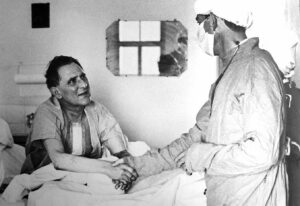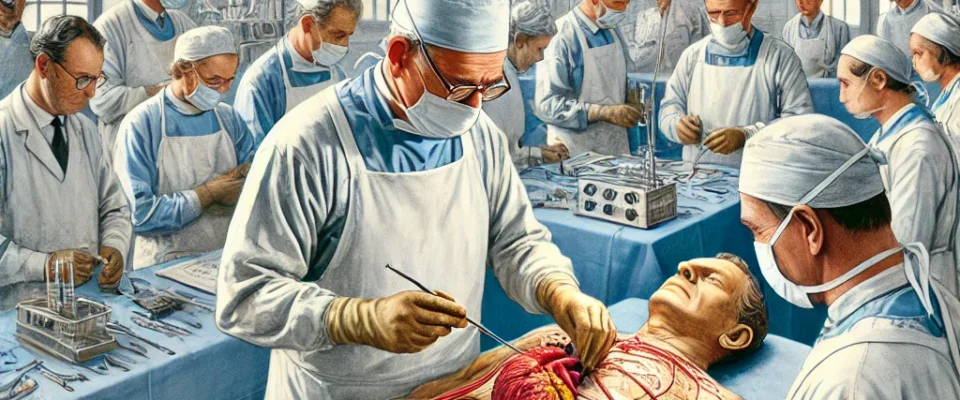Christiaan Neethling Barnard (November 8, 1922 – September 2, 2001) was a South African heart surgeon who performed the world’s first human-to-human heart transplant on December 3, 1967. Born in Beaufort West, Cape Province, Barnard studied medicine and practiced for several years in his homeland of South Africa. As a young doctor experimenting on dogs, Barnard developed a treatment for infant intestinal atresia. His technique saved the lives of ten babies in Cape Town and was adopted by surgeons in the UK and the USA. In 1955, he went to the United States and was initially tasked by Owen Harding Wangensteen to further study the gastrointestinal tract at the University of Minnesota. He was introduced to the heart-lung machine, and Barnard was allowed to switch to the service run by Walt Lillehei, a pioneer of open-heart surgery. Upon his return to South Africa in 1958, Barnard was appointed head of the Department of Experimental Surgery at Groote Schuur Hospital, Cape Town.
In 1967, South African doctor Christiaan Barnard successfully performed the world’s first human heart transplant. This achievement has been praised by 20th-century historians as having social and scientific significance equivalent to the first human landing on the Moon.
Patient Louis Washkansky regained consciousness after the first heart transplant.
On the afternoon of December 2, 1967, a family planned to visit friends and did not want to arrive empty-handed, so they stopped across from a bakery in Cape Town, South Africa. The father, Edward Darvall, and his son waited in the car while his wife and daughter went into the store to buy a cake as a gift. As they crossed the street, both were struck by a speeding car. The mother died instantly, and the 25-year-old daughter, Denise Darvall, was taken to Groote Schuur Hospital in critical condition. The doctors declared Denise Darvall brain-dead.
Devastated by the loss of his wife and daughter, Edward Darvall showed remarkable courage and love by agreeing to donate his daughter’s heart and kidneys for medical purposes. Around the same time Denise Darvall had her accident, cardiologists at Groote Schuur Hospital (South Africa) admitted Louis Washkansky, a 53-year-old patient from the suburbs of Cape Town. He was suffering from end-stage heart failure, causing his heart to barely function properly. His body was swollen, he had difficulty breathing, and he was close to death. Nevertheless, he remained optimistic and bravely fought to keep his fragile life. Professor Velva Schrire, the head of the cardiology team, quickly recognized that the treatment techniques available at the time could not cure all forms of severe heart failure.
As a result, he transferred Louis Washkansky to the Cardiothoracic Surgery Department at Groote Schuur Hospital. Louis Washkansky was ready and brave enough to undergo an untested procedure: a heart transplant. The head of the Cardiothoracic Surgery Department at the time was Professor Christiaan Barnard, who had trained at the University of Cape Town (South Africa) and in the United States. He was a skilled surgeon dedicated to his work. After admitting Louis Washkansky, Barnard assembled a team of talented colleagues to assist him in performing the world’s first heart transplant.
Louis Washkansky would receive the heart of the unfortunate young woman, Denise Darvall. In addition to Barnard’s superior surgical skills, the heart transplant required the expertise of doctors from various specialties. They included cardiologists, radiologists, laboratory technicians, immunologists to ensure the donated heart would not be rejected by the recipient’s body, anesthesiologists to monitor all vital functions, experienced nurses in intensive care, skilled technicians to operate heart-lung machines and other devices, and a blood supply unit to provide compatible blood for the patient.
At midnight on December 2, 1967, the surgery officially began. Before the surgery, Barnard asked Louis Washkansky if he was worried about undergoing a procedure that had never been done before. Washkansky replied, “This is my only chance to survive, so I’ll take it.” By 6 a.m. on Sunday, December 3, 1967, a new heart in Louis Washkansky’s chest had started beating again after a shock. “I feel better” were Louis Washkansky’s words during a conversation 33 hours after the transplant.
The article describing this groundbreaking achievement was published in the South African Medical Journal. Louis Washkansky took immunosuppressive drugs to prevent his body from rejecting the new heart. However, these drugs also made him more susceptible to infections, and he died of pneumonia just 18 days after the surgery. Nevertheless, Washkansky’s new heart functioned normally until his death, and Dr. Barnard quickly became famous worldwide. This event drew international media attention to Groote Schuur Hospital and highlighted the expertise and capabilities of its staff.
The media attention changed many of the rules governing the relationship between medicine and the press at the time. Specifically, the names and faces of heart recipient Louis Washkansky and donor Denise Darvall appeared on the front pages of major newspapers worldwide, breaking the anonymity rules for organ donors and recipients. Furthermore, Dr. Barnard’s first heart transplant was the most widely publicized medical event in history. This is partly because many civilizations have believed that the heart houses the human soul for centuries.
Today, as heart transplants have become a common treatment, people tend to underestimate the enormous courage Dr. Barnard displayed when performing this first surgery. He bravely faced medical, ethical, and legal risks associated with heart transplantation. In the 1970s, the development of better anti-rejection drugs made transplants more viable, and patient longevity could be extended by decades. In 2017, more than 3,000 heart transplants were successfully performed worldwide. Although it remains a risky treatment, it has been carried out nearly 70,000 times over the past 50 years.

